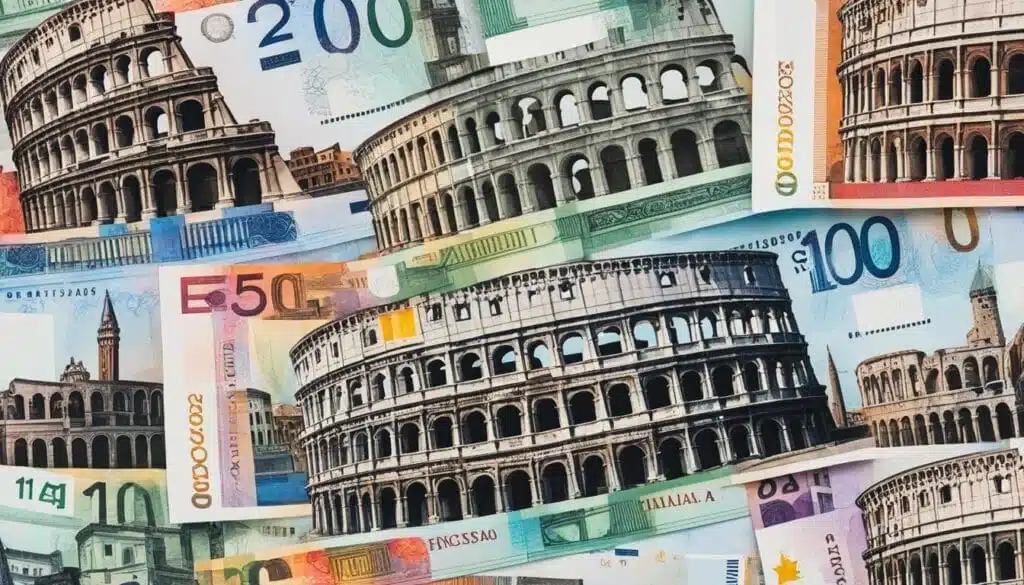Italy Currency : When planning a trip or conducting business in Italy, it’s essential to understand the currency used in the country. Italy is part of the eurozone, and the official currency is the euro. As the second most traded currency worldwide, the euro is widely accepted in shops, restaurants, and establishments throughout Italy.
For travelers and traders, navigating the currency exchange process is crucial. The exchange rate between the euro and other currencies can fluctuate, so it’s important to stay informed about the current rates. You can use a currency converter to calculate the value of your money in euros and vice versa, which can be helpful for budgeting and making informed purchasing decisions.
While electronic payment methods, such as credit cards and debit cards, are commonly used in Italy, it’s still advisable to carry some cash for smaller purchases and emergencies. Paying with cash is especially common in local markets, smaller establishments, and rural areas. It’s also important to familiarize yourself with the various denominations of coins and banknotes to ensure smooth transactions.
In this comprehensive guide, we will delve into the details of Italy’s currency, including the denominations of coins and banknotes, tips for currency exchange, electronic payment methods, and more. With the knowledge and understanding of Italy’s currency essentials, you’ll be well-prepared to manage your money and make the most of your experience in Italy.
Key Takeaways:
- Italy uses the euro as its official currency, which is widely accepted in shops and restaurants.
- Stay informed about the current exchange rates to make the most of your money.
- Carry some cash for smaller purchases and emergencies, as cash is still commonly used in certain situations.
- Familiarize yourself with the denominations of coins and banknotes to ensure smooth transactions.
- Consider using electronic payment methods, such as credit cards and debit cards, for convenience and security.
The Currency Used in Italy
Italy, a popular destination for travelers and traders alike, operates on the euro as its official currency. The euro is not only the currency of Italy but also that of various other countries within the eurozone, making it a widely accepted form of payment throughout the region.
The euro became the official currency of Italy in February 2002, replacing the Italian lira. As a legal tender, the euro plays a crucial role in facilitating financial transactions in Italy.
The currency symbol for the euro is €, which is recognized worldwide and commonly used in transactions across Italy. Whether you’re shopping in a local market, dining in a restaurant, or paying for services, you’ll find that the euro is the currency of choice.
With its wide acceptance and the convenience it offers, the euro ensures that travelers and traders have a seamless experience navigating monetary matters in Italy.
Coins and Banknotes in Italy
The currency used in Italy is the euro, which is represented by both coins and banknotes. The euro coins are available in various denominations, ranging from 1 cent to 2 euros. Each coin has a unique design on one side, representing a different European Union country. The banknotes, on the other hand, come in denominations of 5 euros, 10 euros, 20 euros, 50 euros, 100 euros, and 200 euros.
The following table provides an overview of the denominations of euro coins and banknotes:
| Coin Denomination | Banknote Denomination |
|---|---|
| 1 cent | 5 euros |
| 2 cents | 10 euros |
| 5 cents | 20 euros |
| 10 cents | 50 euros |
| 20 cents | 100 euros |
| 50 cents | 200 euros |
| 1 euro | |
| 2 euros |
These coins and banknotes are legal tender in Italy, meaning they hold a recognized monetary value and can be used for all financial transactions within the country. The euro is the official currency of the eurozone, which consists of European Union countries that have adopted the euro as their currency.
Electronic Payments in Italy
When it comes to making payments in Italy, electronic methods offer convenience and security. In addition to cash, electronic payments are widely used in shops and restaurants throughout the country. From major credit cards to mobile payment systems, here are the various options available:
1. Credit Cards
Major credit cards like Visa, MasterCard, and American Express are widely accepted in most establishments in Italy. From luxury boutiques to local food markets, you can confidently use your credit card for purchases. It’s important to check with your card provider about any international transaction fees and notify them of your travel plans to avoid any potential issues.
2. Debit Cards
Debit cards linked to your bank account are another popular electronic payment method in Italy. Most shops and restaurants accept debit cards, offering a convenient way to make seamless transactions. Just like with credit cards, make sure to inform your bank about your travel plans to prevent any unexpected blocks on your card.
3. Mobile Payment Systems
With the rise of smartphones, mobile payment systems have gained popularity in Italy as well. Services like Apple Pay and Google Pay allow you to make contactless payments using your smartphone. Simply add your credit or debit card information to the app and enjoy the convenience of paying with just a tap on your phone.
| Payment Method | Accepted in Shops | Accepted in Restaurants |
|---|---|---|
| Credit Cards | ✅ | ✅ |
| Debit Cards | ✅ | ✅ |
| Mobile Payment Systems | ✅ | ✅ |
Electronic payments provide a convenient and secure way to make purchases in Italy. Whether you prefer using your credit card, debit card, or mobile payment app, these options are widely available in shops and restaurants across the country. By embracing electronic payments, you can enjoy a hassle-free experience and confidently explore Italy’s vibrant retail and culinary scenes.
Tipping and Receipts in Italy

In Italy, tipping is not compulsory, but it is customary to show appreciation for good service by leaving a tip. It is common to leave around 10% of the bill when satisfied with the service received at shops and restaurants.
Additionally, it is important to ask for and keep receipts or bills for any goods or services purchased in Italy. This is not only for record-keeping purposes but also to ensure compliance with Italian law. All official commercial businesses are required to issue a payment slip, and customers must receive one after every purchase.
This documentation is necessary as it justifies the possession of goods and can help avoid fines if stopped and checked by authorities. Moreover, it allows customers to make use of guarantees or returns for purchased products.
Receipts in Italy: Why They Matter
Receipts or payment slips are essential in Italy for various reasons:
- Compliance with Italian law: All businesses are legally obliged to provide receipts, and customers have the right to ask for them.
- Proof of purchase: Receipts serve as proof of purchase, enabling customers to demonstrate ownership or validate warranty claims or returns.
- Avoiding fines: Authorities in Italy may conduct random checks to ensure compliance with tax regulations. Having proper receipts can help avoid any fines or penalties.
- Financial record-keeping: Receipts assist in maintaining accurate financial records and tracking expenses for personal or business purposes.
By requesting and keeping receipts, visitors and residents in Italy can ensure compliance with the law, protect their rights as consumers, and maintain organized financial records.
Tipping Etiquette in Italy
| Service | Tipping Etiquette |
|---|---|
| Restaurants | 10% of the bill, if satisfied with the service |
| Taxi drivers | Round up the fare |
| Hotel staff | A few euros for bellhops, housekeeping, and other staff members providing additional services |
| Bars and cafes | Small change or rounding up the bill |
| Others (e.g., tour guides, hairdressers) | 10% of the service cost, or as a gesture of gratitude |
Remember that tipping is discretionary and it’s always appreciated to acknowledge good service. However, it’s important to note that some establishments may have a service charge included in the bill, so it’s advisable to check before tipping.
Haggling and Discounts in Italy
When it comes to purchasing items in Italy, haggling over prices is not customary in most shops and stores. However, there are fairs and markets where it is possible to negotiate with traders and potentially get better deals on your purchases.
“Haggling over prices is not customary in most of Italy, especially when purchasing items from shops and stores.”
Aside from haggling, another way to save money is by taking advantage of sales and discounts. Certain periods, such as after Christmas or in early July, are known for offering sales and discounts in various shops throughout Italy. This can be a great opportunity to find quality items at reduced prices.
“Some shops also offer sales or discounts during specific periods, such as after Christmas or in early July.”
While exploring the streets of Italy, you may encounter street vendors selling cheap goods. It is important to exercise caution when dealing with these vendors, as their products may not meet quality standards. Buying from unlicensed sellers is also against Italian law and can lead to legal issues.
“It is important to be cautious of street vendors selling cheap goods that may not meet quality standards. Buying from unlicensed sellers is against Italian law and can lead to legal issues.”
To ensure a safe and reliable shopping experience, it is advisable to shop at reputable establishments and adhere to the local customs regarding pricing and discounts. This way, you can enjoy your purchases without any legal complications.
Comparison of Shopping Practices in Italy
| Practice | Customary in Italy | Legal Implications |
|---|---|---|
| Haggling over prices | Not customary in shops and stores | No legal implications |
| Negotiating at fairs and markets | Possible and accepted | No legal implications |
| Sales and discounts | Offered during specific periods | No legal implications |
| Buying from street vendors | Caution advised | Against Italian law |
Currency Exchange in Italy

When traveling to Italy, it’s essential to be aware of the currency exchange options available. Here are the key ways to exchange your money:
ATMs (Bancomats)
ATMs, known as bancomats in Italy, are the most common and convenient way to withdraw cash in euros. They are widely available throughout the country and can be easily found in major cities, towns, and tourist areas. Most ATMs do not charge additional fees for withdrawals, but it’s important to check with your bank for any associated fees or usage limits.
Currency Exchange Outlets (Cambios)
If you prefer to exchange cash in person, currency exchange outlets, called cambios, are available throughout Italy. These establishments offer currency exchange services and can help you convert your money into euros. However, it’s important to note that fees and exchange rates can vary between different cambio locations. It’s recommended to compare rates and fees before making an exchange to ensure you get the best value.
Traveler’s Cheques
Traveler’s cheques are not widely accepted in Italy and can be difficult to use. Many businesses, including hotels, restaurants, and shops, do not accept traveler’s cheques as a form of payment. It’s advisable to carry alternative forms of payment, such as cash or credit cards, for easier transactions.
Banknote Condition
When exchanging cash, it’s important to ensure that your banknotes are in good condition. Some exchange services may reject damaged or defaced banknotes, so it’s essential to check your notes before exchanging them. If any banknote is defaced or heavily worn, it’s best to exchange it at a local bank or check with the currency exchange outlet beforehand.
To get the most out of your currency exchange experience, compare rates and fees, use reliable sources, and plan ahead to ensure you have enough local currency for your trip.
Buying Italian Currency Before You Go

Planning a trip to Italy? Don’t forget to ensure you have enough Italian currency to make your transactions smooth and hassle-free. Here are some options for buying Italian currency before you go:
1. Online Currency Exchange Services
If convenience is a top priority for you, consider using online currency exchange services. These platforms offer the flexibility of home delivery or in-store pickup, allowing you to get your hands on the Italian currency right when you need it. You can compare exchange rates and fees from different providers to ensure you’re getting the best deal for your money.
2. Comparing Exchange Rates and Fees
When buying Italian currency, it’s crucial to compare exchange rates and fees offered by different providers. This will help you get the most value out of your exchange. Keep in mind that exchange rates fluctuate, so staying updated with the latest rates is important. Take your time to research and choose a provider that offers competitive rates and minimal fees.
3. Processing Time
Some online currency exchange services may require a few days to process currency orders, so it’s essential to plan ahead and account for this processing time. Make sure you initiate your currency purchase well in advance to avoid any last-minute delays or inconvenience.
4. Airport Exchanges
While it’s convenient to buy currency at the airport, it’s advisable to avoid airport exchange counters if possible. They often charge higher rates and fees compared to other exchange options. Instead, explore other currency exchange avenues outside the airport to secure more competitive rates and fees.
Take a look at this table for a quick comparison of different currency exchange options:
| Exchange Option | Advantages | Disadvantages |
|---|---|---|
| Online Currency Exchange Services | – Convenience of home delivery or in-store pickup. | – Processing time required. – Possible delivery fees. |
| Airport Exchanges | – Convenient at the airport. – Immediate access to local currency. | – Higher rates and fees compared to other options. – Limited currency availability. |
| Local Banks and Currency Exchange Outlets | – Competitive rates and fees. – Wide range of available currencies. | – Limited location options. – Possible service fees. |
Remember to consider your own requirements and preferences when choosing the most suitable option for buying Italian currency before your trip. By planning ahead and making an informed decision, you can ensure a smooth and enjoyable experience while using local currency in Italy.
Also Read : How Can I Create A Successful Budget For My Household?
Conclusion
Understanding the currency used in Italy and how to navigate currency exchange and payment methods can greatly enhance the travel experience for visitors to the country. The euro serves as the official currency of Italy and is widely accepted in various establishments, including shops, restaurants, and hotels. It is essential to familiarize oneself with the denominations of coins and banknotes and stay updated on the current exchange rate when exchanging currency.
In addition to cash, electronic payment methods such as credit cards and debit cards are commonly used in Italy. However, it is advisable to also carry some cash for smaller purchases and emergencies, as not all places may accept cards. Tipping customs, receipt requirements, and haggling practices can vary, so it is important to be aware of the local customs and laws.
By being prepared and informed about Italy’s currency essentials, travelers and traders can make the most of their trip and effectively manage their travel money. Whether it’s exploring the historic sites, indulging in authentic Italian cuisine, or shopping for exquisite souvenirs, having a good understanding of the currency and payment methods will ensure a seamless and enjoyable experience in the beautiful country of Italy.
FAQs
What currency is used in Italy?
The official currency of Italy is the euro.
Are credit cards widely accepted in Italy?
Yes, credit cards, such as Visa, MasterCard, and American Express, are widely accepted in shops and restaurants in Italy.
Do I need to tip in Italy?
Tipping is not compulsory in Italy, but it is customary to leave a tip of around 10% of the bill when satisfied with the service.
Do I need to keep receipts for purchases in Italy?
Yes, it is important to ask for and keep receipts or bills for any goods or services purchased in Italy. This is required by Italian law.
Can I haggle over prices in Italy?
Haggling over prices is not customary in most of Italy, especially in shops and stores. However, it may be possible to negotiate at fairs and markets.
Where can I exchange currency in Italy?
Currency can be exchanged at ATMs (bancomats) and currency exchange outlets (cambios) throughout Italy. It is advisable to compare rates and fees before making an exchange.
Can I buy Italian currency before traveling to Italy?
Yes, it is possible to buy Italian currency before traveling to Italy. Online currency exchange services offer home delivery or in-store pickup options.
What is the value of the euro compared to other currencies?
The value of the euro can fluctuate against other currencies. It is recommended to check the current exchange rates or use a currency converter to calculate the value of your money in euros.
What is the best option for electronic payments in Italy?
Major credit cards, debit cards linked to bank accounts, and mobile payment systems like Apple Pay and Google Pay are commonly used for electronic payments in Italy.





